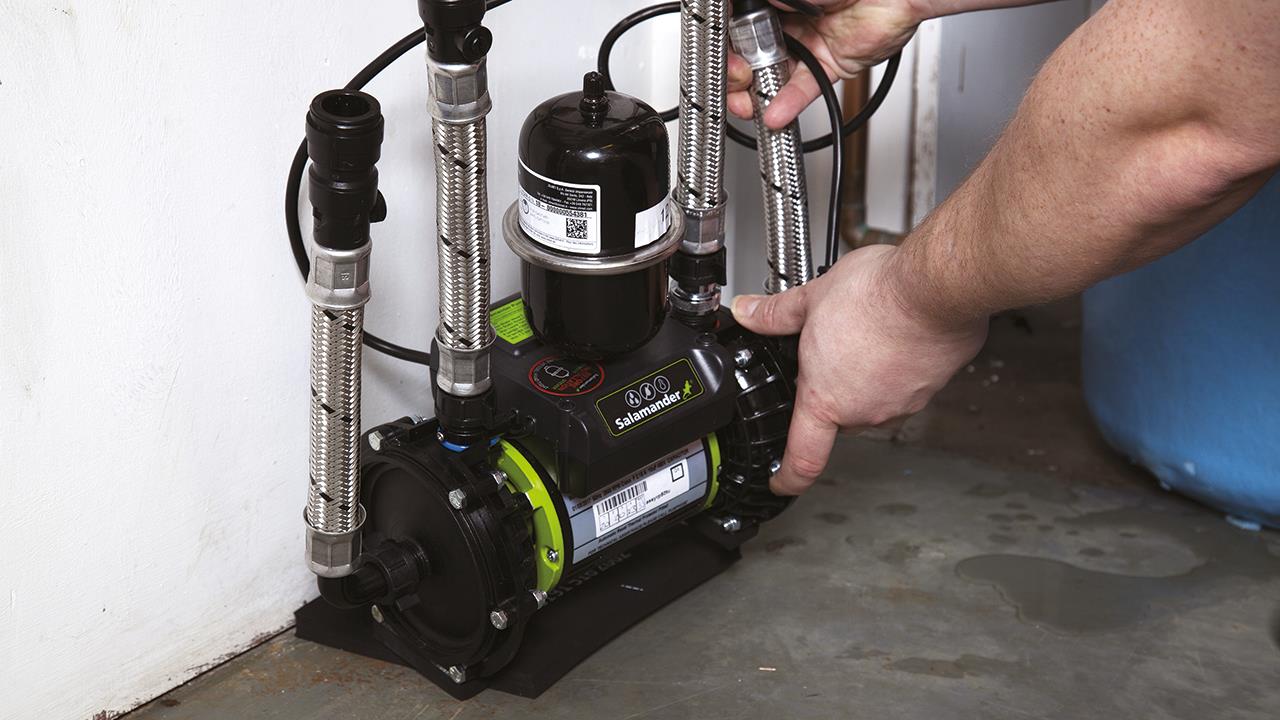


Richard Harvey, Commercial Director at Wolseley, looks at the different types of shower pumps available to installers and what they need to consider when specifying the correct product.
Shower pumps are a huge replacement market, and data from manufacturer Stuart Turner suggests that around a quarter of a million units are sold in the UK every year.
Whether replacements are required through changes to the heating and water system or in order to supply the flow rates required for modern brassware and showers, installers must be able to distinguish what’s best for the job.
Most homes in the UK are still gravity-fed, but newer systems may have combi or system boilers. The difference will massively impact the choice of shower pump for the job. Digital showers are also providing a surge in pump sales as customers look for fittings that combine additions such as drench head showers, digital jets, and handheld showerheads. To provide this, installers must increase the flow rate with a pump, particularly in dwellings such as three-story houses or multigenerational homes where multiple outlets may be in use at any given time.
Positive and negatives
In gravity-fed systems, the gap between the bottom of the cold water storage tank and the highest point in the pipework or highest outlet determines whether the system is positive or negative head. Positive head pumps will only work in positive head systems. Negative head pumps, also known as universal pumps, will work in both situations.
If the distance between the cold water storage tank and the highest point in the system after the pump is more than 600mm, then a positive head is required. Positive head pumps are the most common in British homes.
In some homes, however, there won’t be room to install a pump below the tank and will therefore require a negative head pump which is placed above or level with the tank. As these pumps are automatic, they perform under both positive and negative head conditions and don’t require a minimum gravity flow of water to work. The pump draws water from the tank and sends it towards the shower. Universal pumps are also suitable for open vented hot and cold systems.
For customers with unvented cylinders, pressure usually isn’t an issue as the utility companies usually maintain mains supply pressure. The problem lies in larger homes or homes with multiple showers being used at similar times where flow rates can then be negatively impacted, and the cylinder can drain quickly. Here, a cold water accumulator will be needed to balance it out.
Investigating impellers
There are two types of impellers to consider depending on the installation situation; centrifugal and regenerative.
The pump should always be installed as close to the hot water cylinder as possible, but, if the pump is fitted in the loft space, installers should opt for a pump with a regenerative impeller as their performance is less likely to be negatively affected by air that’s accumulated within the system. Regenerative options are designed to remove air from the system, are easier to install, and are more affordable, however they do offer slightly lower flow rates in comparison with their centrifugal counterparts. This option is also preferable when dealing with pipework that contains many bends and elbows.
Centrifugal pumps draw water in and push it out under pressure created by an internal impeller. They are ideal for when the pump is installed 2m below the height of the cold storage tank. This option is more efficient in delivering higher flow rates, and they are renowned for being quieter than regenerative pumps but are less able to remove air from the system. Centrifugal pumps are also more sensitive to water temperature, air locking, and cavitation.
It’s also worth noting whether a single or twin pump is required. A single impeller pump will be required when looking to improve the hot water feed alone. For installers that need to create even higher pressures in both hot and cold feeds, twin pumps with two impellers, sometimes known as multistage pumps, are available. Their ability to improve pressure in both feeds makes them more popular among customers.
Pressure ratings
The type of shower or showerhead fitted will determine which pressure rating to look out for when buying a pump. For small showerheads, opt for a 1 bar pump. For normal showers that just require more pressure, a 1.5 or 2 bar shower pump will suffice. When it comes to power showers or showers with larger heads, a higher pressure is required so look for anywhere between 2 and 2.5 bars. A 3 bar shower pump will be required for power showers and larger showerheads, and showers with multiple functions such as body jets. These 3 bar pumps are also ideal for houses with multiple outlets.
With so many pumps on the market and each more suited than another depending on the application, it’s advisable to stay up to date with the latest technology. Companies like Salamander and Stuart Turner have a range of eTraining courses and approved training centres nationwide covering product selection, installation, fault diagnosis, and repair
If you'd like to keep up-to-date with the latest developments in the heating and plumbing industry, why not subscribe to our weekly newsletters? Just click the button below and you can ensure all the latest industry news and new product information lands in your inbox every week.